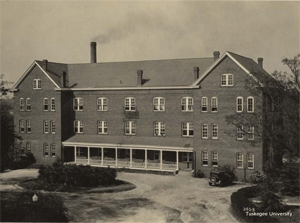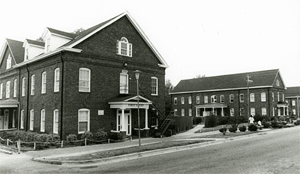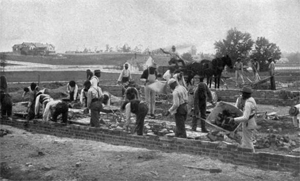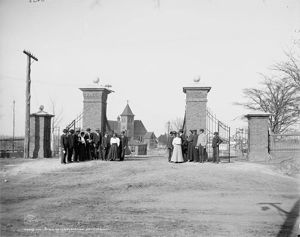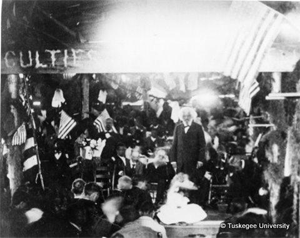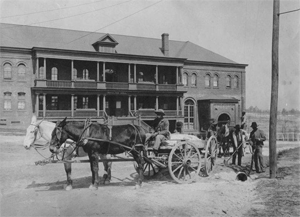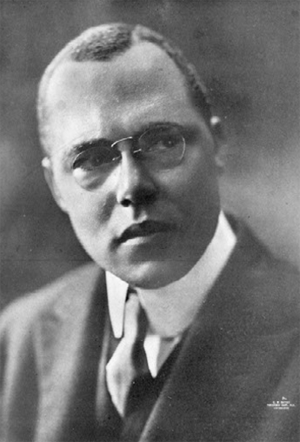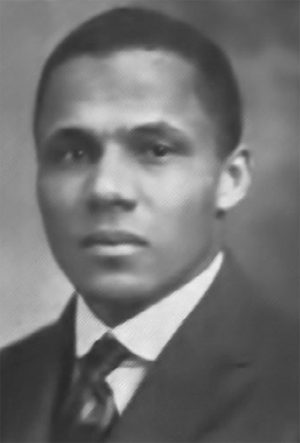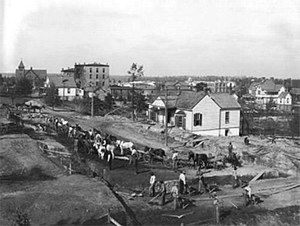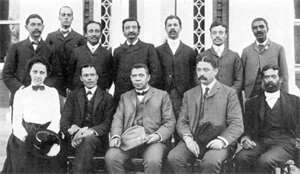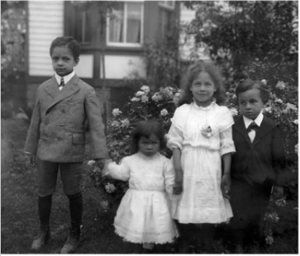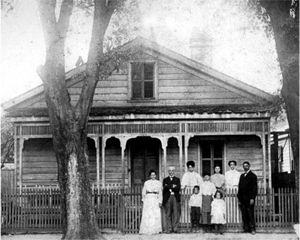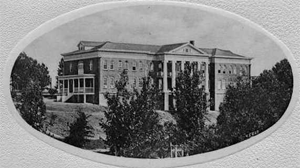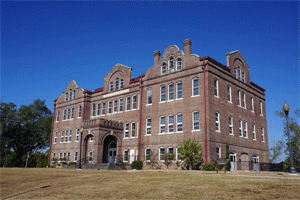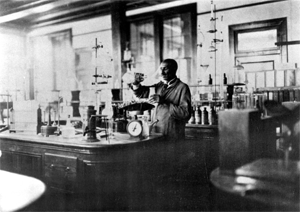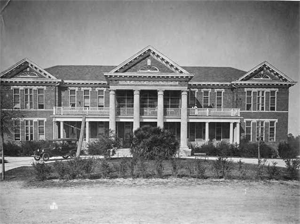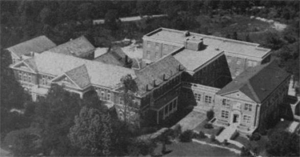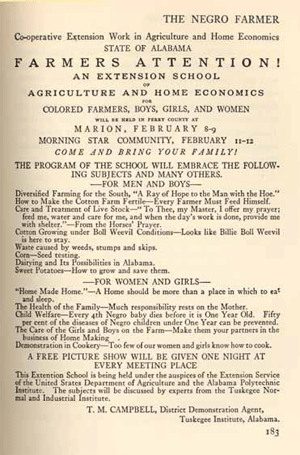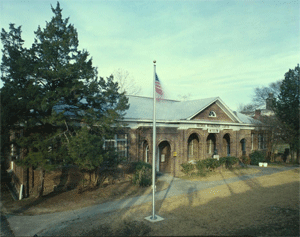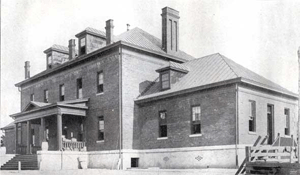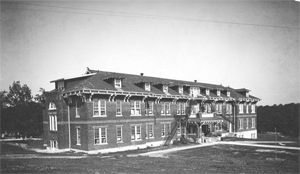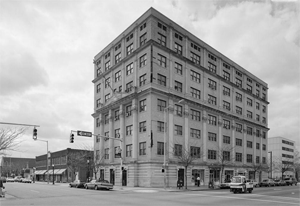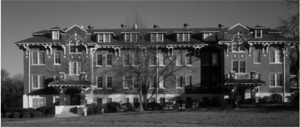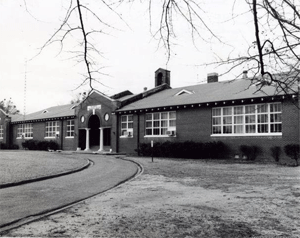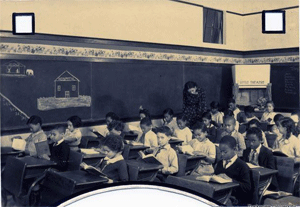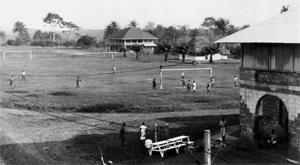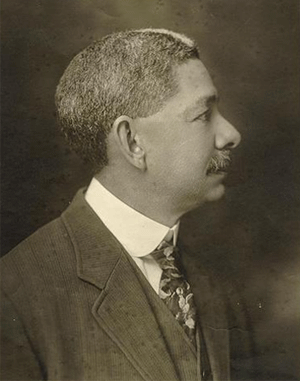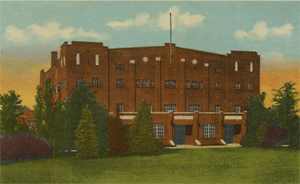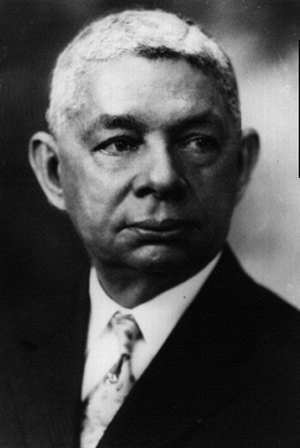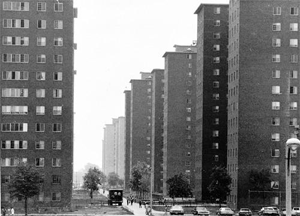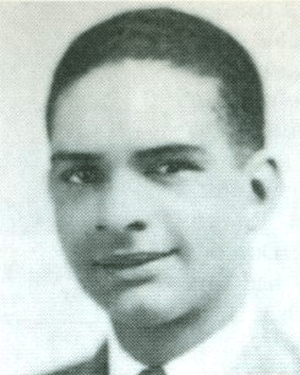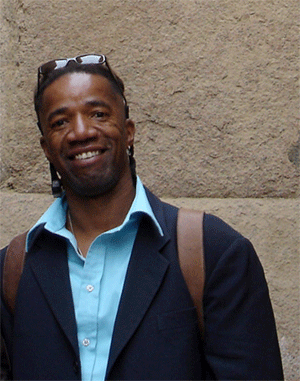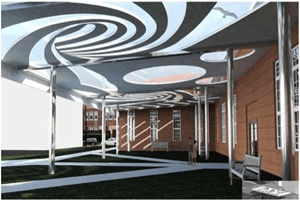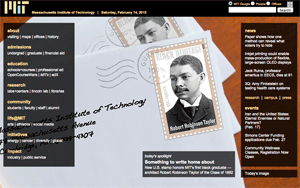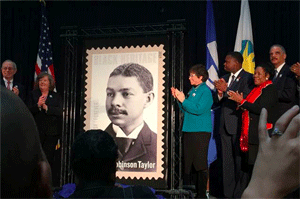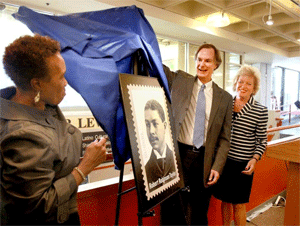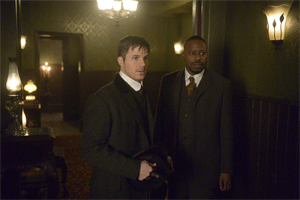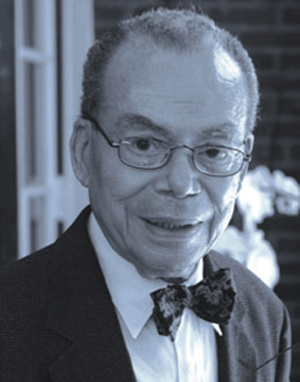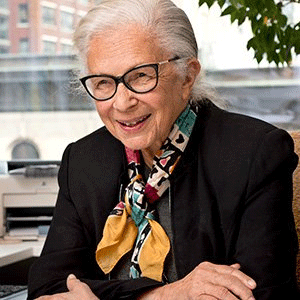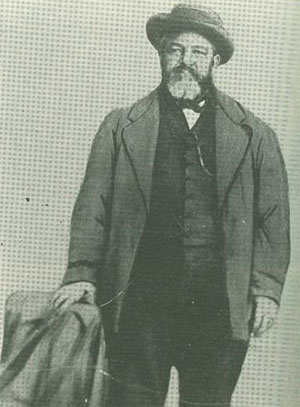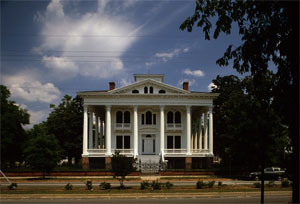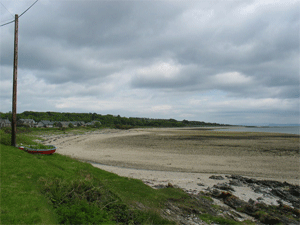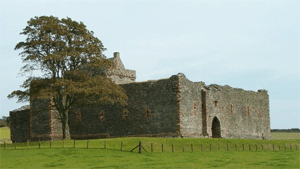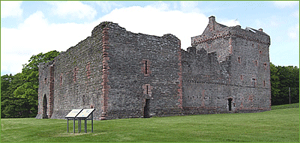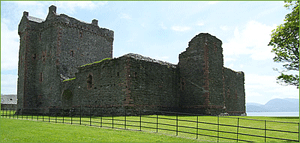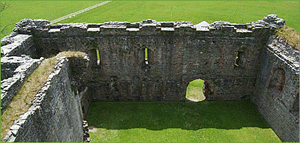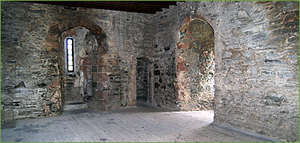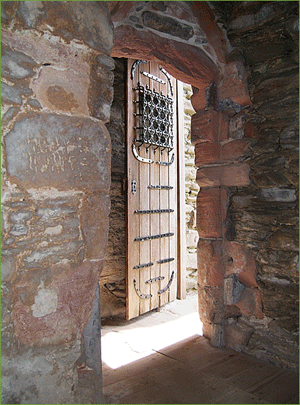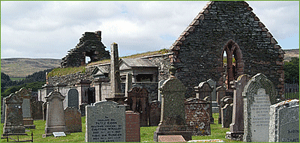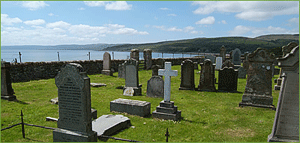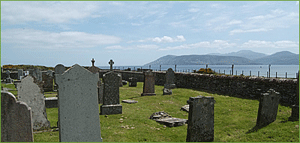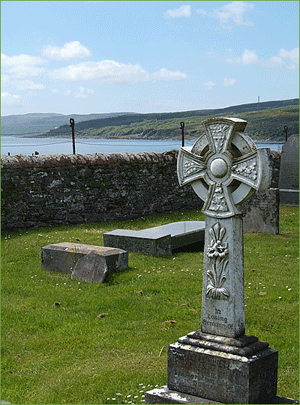Robert R. Taylor: First Black Student at MIT
by MIT Black History
Accessed: 7/20/18
NOTICE: THIS WORK MAY BE PROTECTED BY COPYRIGHT
YOU ARE REQUIRED TO READ THE COPYRIGHT NOTICE AT THIS LINK BEFORE YOU READ THE FOLLOWING WORK, THAT IS AVAILABLE SOLELY FOR PRIVATE STUDY, SCHOLARSHIP OR RESEARCH PURSUANT TO 17 U.S.C. SECTION 107 AND 108. IN THE EVENT THAT THE LIBRARY DETERMINES THAT UNLAWFUL COPYING OF THIS WORK HAS OCCURRED, THE LIBRARY HAS THE RIGHT TO BLOCK THE I.P. ADDRESS AT WHICH THE UNLAWFUL COPYING APPEARED TO HAVE OCCURRED. THANK YOU FOR RESPECTING THE RIGHTS OF COPYRIGHT OWNERS.
MIT's first black graduate, nation's first accredited African-American architect, designer of Tuskegee Institute campus buildings prior to 1932, great-grandfather of Valerie Jarrett, and more...
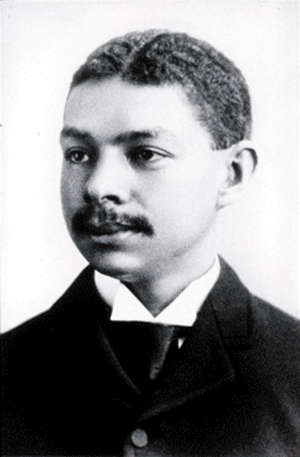
Courtesy MIT Museum
In September 1888, a young African American traveled from Wilmington, North Carolina to Boston, Massachusetts to sit the examination for entrance to MIT. Robert Robinson Taylor was brimming with enthusiasm, despite skepticism on the part of friends and relatives back home.
When it was known that I was to leave my home to study at the [MIT], many of the home people asked, 'What is the use?' And a question of similar nature was asked by many in other places. "After graduation, what? Where is the field?"
Robert R. Taylor, "The Scientific Development of the Negro," 50th Anniversary of the Charter of MIT, 10 April 1911
EARLY YEARS: ROOTS AND FOUNDATIONS
Born on June 8, 1868 in Wilmington, North Carolina, Robert Taylor came from a relatively privileged family background. His father, Henry Taylor, was the son of a white slave owner and a black mother, and as such had been allowed enough freedom before the Civil War to go into business for himself. He moved to Wilmington, NC in 1850, where he worked as a carpenter.
Henry Taylor developed a prosperous career as a contractor and builder, constructing cargo ships that plied trade routes between the United States and South America via the Caribbean. Also active in building construction, he erected a number of commercial and residential edifices in the Wilmington area and elsewhere. According to family tradition, Taylor the elder worked on the Bellamy Mansion Museum and other antebellum buildings. He also operated a grocery story and was active in many of the civic and religious affairs of the city. Taylor the elder was a member of Giblem Masonic Lodge, and a founding member of the local Republican Party.
Taylor's early schooling took place in Wilmington at the Williston School and later at the Gregory Normal Institute, a school for blacks operated and maintained by the American Missionary Association. After graduating, he worked in his father's business and learned the rudiments of the building trade.
Both father and son soon agreed that the younger Taylor should formalize his technical training. Though as a boy Taylor had hoped to attend the elite Lincoln University near Philadelphia (which would grant him an honorary doctorate in later years), they set their sights on MIT, arguably the institution with the best program in architecture available. Founded in 1865, MIT's School of Architecture offered the first formal architectural curriculum in the United States, and the first architecture program in the world, operating within the establishment of a University.
AT THE INSTITUTE: ABOVE AVERAGE
Academic Performance
The class of 1892 was the largest on record since the Institute's founding 328 registered for the fall semester of 1888. Having worked in his father's business for a period, Taylor entered MIT a couple of years older than the average freshman coming straight out of high school. Also, he was one of a mere handful of students from the South; most MIT students at the time were New Englanders, with a smattering from other parts of the country and from overseas.
In fact, there was a prejudice of sorts against Southerners, even against those white and black--whose families hailed originally from the South. An 1887 article in the student newspaper The Tech, for example, referred to a region of southern Ohio as "the lazy belt," so named because of "certain characteristics of its inhabitants" who" in past time have wandered westward from the 'Old Dominion'.”
Taylor nevertheless appears to have adjusted quite well to his new environment, at least academically. His record at MIT during the four years he attended, 1888-1892, was above the class average. He earned honors in trigonometry, architectural history, differential calculus, and applied mechanics, never failing a course. Taylor held a Loring Scholarship for two consecutive academic years and may have been the first recipient. The Loring Scholarship was one of the several stipends available to MIT students who had proven their potential through hard work and superior performance.
Thesis Work
In addition to his overall academic record, Taylor's "promise of future usefulness" was evident in the subject he chose as a final project for his major in architecture (Course IV). The project, entitled "Design for a Soldiers' Home," involved creating plans for a nursing or convalescent home for aged, infirm Civil War veterans.
This segment of the population had been rapidly increasing in number and was still the source of considerable social concern almost thirty years after the end of the war. The federal government had already begun to tackle the problem of long-term care for veterans facilities, a development Taylor's thesis introduction addresses. Taylor would use many of the ideas developed in his thesis to professional advantage later in his career.
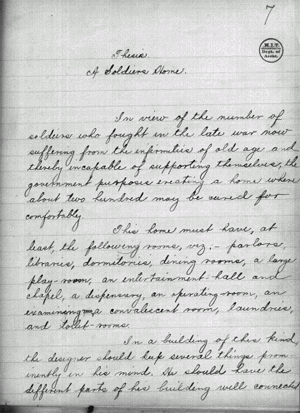
First page of Robert R. Taylor's senior thesis, "A Soldiers Home," which includes eight handwritten pages and two architectural drawings, 1892. Courtesy Institute Archives/MIT Libraries

Taylor's architectural drawing (front view) for "A Soldiers Home," 1892. Courtesy MIT Museum
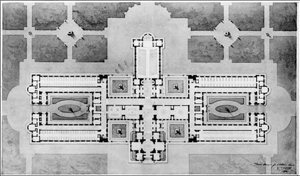
Taylor's architectural drawing (top view) for "A Soldiers Home," 1892. Courtesy MIT Museum
In view of the number of soldiers who fought in the late war now suffering from the infirmities of old age and thereby incapable of supporting themselves, the government purposes erecting a home where about two hundred may be cared for comfortably.
This home must have, at least, the following rooms, viz, parlors, libraries, dormitories, dining rooms, a large play-room, an entertainment hall and chapel, a dispensary, an operating room, an examining room, a convalescent room, laundries, and toilet-rooms.
In a building of this kind, the designer should keep several things prominently in his mind. He should have the different parts of his building well connected in order to allow free circulation; still, he ought not connect too intimately the hospital with parts of the building designed for other uses. Then, as the inmates of the home are infirm, he should use the greatest allowable area and as few stories as possible in order to avoid climbing several flights of stairs. For whatever purpose intended, he should have his rooms large, well lighted, and well ventilated.
Robert R. Taylor, "A Soldiers' Home," 1892
Taylor's was an ambitious plan, undoubtedly more elaborate than anything the federal government would have been willing to adopt for this purpose. The overall scheme reflected both the style of large French institutions and the problems studied and taught at the Ecole des Beaux Arts in Paris, where many members of the architecture faculty at MIT had been trained.
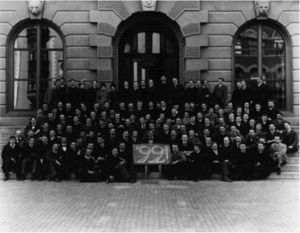
MIT Class of 1892, the largest on record since the Institute opened its doors in 1865
TUSKEGEE RECRUITMENT: BOOKER T. WASHINGTON AND HIS EDUCATIONAL VISION
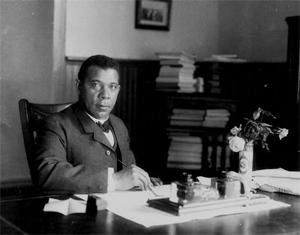
Booker T. Washington at Tuskegee Institute near his 25th year of leadership, ca. 1905.
Booker T. Washington and Tuskegee Institute
During Taylor's course of study at MIT, he had talked in person on more than one occasion with Booker T. Washington, the prominent black educator and race leader from Tuskegee, Alabama. In 1881, about a decade earlier, Washington had founded Tuskegee Institute--a black school that had started as a normal (teacher-training) school with a few ramshackle buildings and a small grant from the state of Alabama.
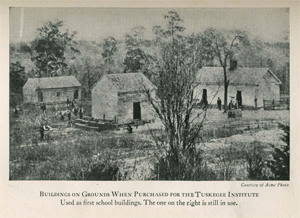
Postcard depicting the structures on the grounds when the site for the Tuskegee Institute was purchased and which served as the first school buildings. Photo: Acme Photo, reproduced from Up From Slavery: An Autobiography by Booker T. Washington (Doubleday & Company, Inc., 1901)
Within a couple of decades, Tuskegee became one of the best-known African-American schools in the nation, with substantial funding from Northern philanthropists, industrialists, and businessmen such as Andrew Carnegie and Julius Rosenwald.
In contrast with the emphasis placed on intellectual pursuits by W. E. B. Du Bois and some other contemporary black leaders, the curriculum at Tuskegee stressed manual training, industrial education, and useful crafts that would prepare students for jobs. Washington advocated a gradualist rather than a radical approach to improving conditions for blacks in the post-Emancipation period, with hard work and self-help as the primary channels to economic and social advancement. This philosophy found ready acceptance among whites, both north and south, and among many blacks.
It is not certain exactly how or when Washington got wind of Taylor's excellent record at MIT, but he was often on the lookout for qualified black students to recruit for leadership roles at Tuskegee. He had made a fundraising tour through New England as early as 1882 and quickly developed contacts within a number of organizations interested in educational work in the South. Among them were the Woman's Home Missionary Association in Boston and the Women's New England Club. His trips were intended, in part, to establish a close relationship with wealthy, influential Bostonians who might contribute to the Tuskegee cause.
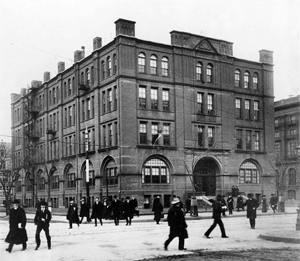
The MIT campus was originally located on Boylston and Clarendon Streets in Boston's Back Bay and was moved across the Charles River to Cambridge in 1916. Courtesy MIT Museum
While in Boston, Washington lodged near the old MIT campus at Boylston, Clarendon, and Exeter Streets. It was during one or more of these excursions that he and Taylor discussed the possibility of a role for Taylor at Tuskegee. What Washington had in mind was for Taylor to develop the nascent industrial program at Tuskegee and to plan and direct the construction of new buildings for the campus.
Taylor seemed like an ideal recruit for several reasons: he was black, a Southerner, bright, a hard worker, and Iast but not least--the recipient of a sound education at the premier technical institute in the country. The emphasis placed at MIT on applied, practical aspects of science and engineering was more in line with the Tuskegee mission than, say, the focus on a classical, liberal arts education at Harvard. Ironically, W.E.B DuBois was beginning his doctoral studies in history at Harvard around the time that Washington and Taylor were discussing Taylor's possible move to Tuskegee.
Recruitment
Taylor did not head directly to Tuskegee immediately after graduation. He may have worked during the summer of 1892 for an architectural firm in Cleveland, Ohio. By his own testimony, he "took up the practice of architecture and designed several private and public buildings." The encounters with Booker T. Washington in Boston, however, had inspired an interest in somehow combining architecture with a career in the field of education. Taylor had also received offers from four other schools to organize and direct industrial programs. But Taylor had "some hesitancy". He was more interested in going into business for himself than in teaching. Finally, after a visit to the campus in Alabama, Taylor accepted the Tuskegee offer.
MIT-TUSKEGEE CONNECTION: MODELING EXCELLENCE
To develop a sound curriculum at Tuskegee, both Washington and Taylor would look to MIT as a model. In 1894, Washington sought the advice of Ellen Swallow Richards '73 on the matter of staff recruitment. Richards was MIT's first woman graduate (Class of 1873), who became a member of the MIT faculty in 1878 and created the first sanitary engineering laboratory in the United States.
Just as in Massachusetts they have the Institute of Technology and the Simmons Industrial School, so in the South there should be the Atlanta University, the Tuskegee Institute and others. There is a place for all these institutions to do their work. I do not believe in placing any limitation upon the mental development of the black man.
Booker T. Washington to journalist Oswald G. Villard, 1904
Near 1888, Richards joined other women (including the wife of a Harvard professor and Stella Houghton Scott Gilman, a pioneer in women's education at Harvard) in urging Washington to establish at Tuskegee a department for the training of domestic servants.
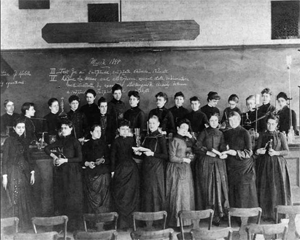
Women students in the lab of Ellen Swallow Richards (far left, rear) holding scientific instruments, 1888. Courtesy MIT Museum
Taylor's own admiration for MIT as a model for Tuskegee's development would later be conveyed in a speech he would deliver at MIT in 1911 to celebrate the Institute's 50th birthday.
THE INSTITUTE HAS STEADILY ADVANCED IN POWER AND INFLUENCE...ITS EDUCATIONAL POLICY HAS SERVED AS A MODEL FOR NUMEROUS SIMILAR INSTITUTIONS IN THIS COUNTRY AND ABROAD...
- Robert R. Taylor, "The Scientific Development of the Negro", 10 April 1911
BUILDING TUSKEGEE: 1892-1932
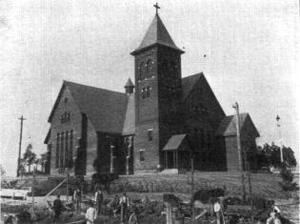
The Chapel at Tuskegee Institute, designed by Robert R. Taylor and completed in 1898.
AND I REMEMBER THE CHAPEL WITH ITS SWEEPING EAVES, LONG AND LOW AS THOUGH RISEN BLOODY FROM THE EARTH LIKE THE RISING MOON; VINE-COVERED AND EARTH-COLORED AS THOUGH MORE EARTH-SPRUNG THAN MAN-SPRUNG.
- Ralph Ellison, Invisible Man, 1952
Robert Taylor was the architect who "earth-sprung" many of Tuskegee Institute's campus buildings before 1930, including The Chapel so vividly described by Tuskegee alum Ralph Ellison in Invisible Man. Both The Chapel and the literary work it inspired would be considered masterpieces of their respective creators.

Ralph Ellison upon his arrival to Tuskegee as a student, 1933

1st-edition book cover of Ellison's first and only novel, Invisible Man (Random House, 1952)
After a brilliant 40-year career as a professor and architect at Tuskegee, Taylor would collapse in the very Chapel he designed and built, later to pass away in the hospital he also designed and built. By then he would be known as a hard, productive worker and devoted advocate of Booker T. Washington's educational and social vision. Taylor's reputation as the individual primarily responsible for Tuskegee's architectural beauty and coherence long survived him; his "blending of art and science," according to Frederick D. Patterson (Tuskegee president, 1935-1953), was recognized in the eventual designation of the campus as a National Historic Site.
Arrival to Tuskegee
Taylor arrived at the Tuskegee Institute in the fall or winter of 1892. He would serve as an instructor in architectural drawing and architect until 1899. His entire career would be spent at Tuskegee--with the exception of a brief leave of absence from 1899 to 1902.
When he first took up his position as architect and instructor in architectural and mechanical drawing at Tuskegee, Taylor found that
the mechanical work was largely in the hands of men trained in the old way, who did their work usually without definite plans or drawings. Introducing plans, blue-prints and specifications as a part of every mechanical job, however small, and instructing the students in making and using drawings, led to changes which inevitably follow newer and better ways of doing things.
Robert R. Taylor, The Scientific Development of the Negro, 1911
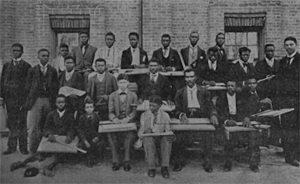
Mechanical-drawing students at Tuskegee Institute, shown with instructor Robert R. Taylor (far right), ca. 1897.
Other notable hires at Tuskegee after Taylor included scientist and inventor George Washington Carver, who joined the faculty to head of the agricultural department in 1896 after earning bachelor's and master's degrees at Iowa State College of Agriculture and Mechanic Arts.
I remember my father telling me about this great man George Washington Carver and taking me to the Institute to his laboratory...[he had] a model, miniature house that children could play in...I have some sense of "there are such people in this world"...Tuskegee was a very important kind of anchor for me.
MIT political science professor Willard R. Johnson in Technology and the Dream, 1996
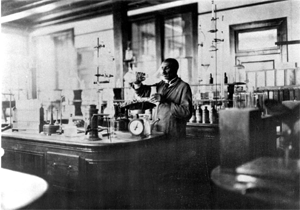
George Washington Carver at work in his laboratory, located at Tuskegee Institute's Milbank Agriculture Building, designed by Robert R. Taylor. Photo: Erick Butler, AP Photo/Courtesy Tuskegee University
Taylor's value to Tuskegee would go beyond diligence and selfless devotion to Washington's cause. He managed to exert a healthy influence over Washington himself, demonstrating by personal example the danger of focusing on "manual arts" at the expense of all else.
In 1907, for example, when Washington remarked that "We must not only have carpenters but architects; we must not only have persons who can do the work with the hand but persons at the same time who can plan the work with the brain," he was expressing an outlook that was less rigid, more expansive than it had been a decade earlier.
This outlook was certainly modified, at least in part, by his relationship with Taylor. Taylor's outlook, in turn, had been shaped to a considerable extent by his experience at MIT, whose motto mens et manus (mind and hand) captured the very duality that Taylor--and, under his influence, Washington--came to espouse at Tuskegee.
TAYLOR'S BUILDINGS [AT TUSKEGEE] CREATED AN INSTITUTIONAL PRESENCE BY GIVING A SENSE OF PLACE AND OWNERSHIP FOR AFRICAN AMERICANS WHO HAD TOO LITTLE OF EVERYTHING.
-- Biographer Ellen Weiss, Tulane University, 2012
Science Hall / Thrasher Hall (1893)
Taylor's first building on campus was completed in 1893. Science Hall housed science classrooms and laboratories. The proportions and parts of the design hearkened back to Taylor's MIT thesis, completed just a year earlier.
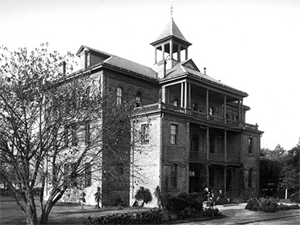
Science Hall was the first Tuskegee building designed by Taylor and completed in 1893, later renamed Thrasher Hall.
Science Hall was constructed entirely by students, using bricks made also by students under Taylor's supervision. The project epitomized Washington's philosophy of instilling in Tuskegee students, the descendants of former slaves, the value and dignity of physical labor. Their efforts provided an example to the world--and especially to potential donors--of the capabilities of blacks in the building trades, underscoring the larger potential of the manual training curricula being developed at Tuskegee.
In 1903, Science Hall was renamed Thrasher Hall in honor of Max Bennett Thrasher, who authored Tuskegee: Its Story and Its Work (Boston, Small, Maynard & Company, 1900), with an introduction by Washington. A number of other campus buildings followed. Not all were completed by Taylor, who was away from Tuskegee (except for short visits) from 1899 to 1902.
The Chapel (1898)
Erected between 1895 and 1898, The Butler Chapel featured a 105-foot tower, dual entrances for boys and girls, seating capacity for 2,400--and the high-arched hammer-beam trusses that ultimately made their way into one of the 100 best English-language novels of the 20th century.
Booker T. Washington referred to the Chapel as the "most imposing building" at Tuskegee. Funded by the Phelps Stokes Family (New York philanthropists), the Chapel was a graceful, round-arch structure and the first electrified building in Macon County, Alabama. The interior electrical lights were installed by the instructor and students of the school's electrical division.
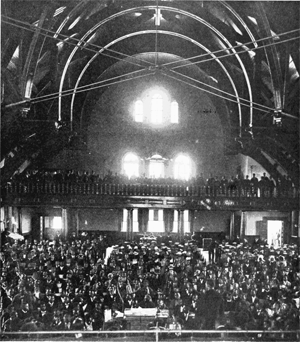
Interior of The Chapel, shown during a conference in session. Source: Thrasher, M.B. "Tuskegee Institute and Its President." Popular Science Monthly, Vol. 55 (September 1899).
At the Chapel's dedication, black journalist Timothy Thomas Fortune wrote a piece in the New York Sun (3 April 1898) urging every southerner to make at least one pilgrimage to view this “cathedral in the Black Belt”. Such a pilgrimage would unfortunately not be possible after the night of January 23, 1957, when The Chapel was destroyed by a fire. Another chapel was completed on the same site in 1969, with funding from alumni.
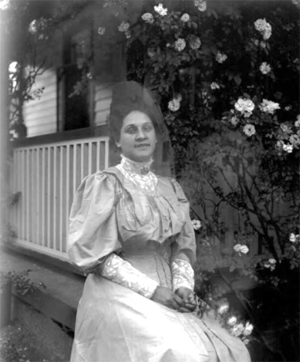
Beatrice Rochon Taylor, first wife of Robert R. Taylor, 1906. Photo: Frances B. Johnston, Courtesy Library of Congress (Frances Benjamin Johnston Collection)
In 1898, Taylor married Tuskegee English schoolteacher Beatrice Rochon Taylor in Louisiana. They would have four children: Helen, Robert Rochon, Helen, Edward, and Beatrice.
The Oaks (1899)
The Oaks is a handsome brick president's house. While living there, Washington dispensed “a generous hospitality to the school's guests and to the teachers of the Institute". The building is a contributing property to the Tuskegee Institute National Historic Site and National Landmark.

The Oaks, designed by Robert R. Taylor, was completed in 1899 and served as the president's house at Tuskegee Institute.
Huntington Hall (1899)
Collis P. Huntington, "one of Tuskegee's stanchest supporters," had made his fortune in the railroad business and was the president of the Cheasapeake and Ohio Railroad. Completed in 1899 with funds donated by Huntington's widow, Huntington Hall served as a women’s dormitory. The building would later be used as the residence of staff members and also house classrooms and faculty offices.
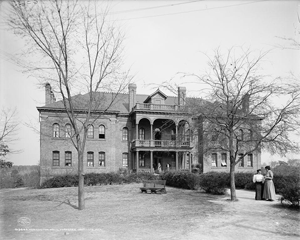
Huntington Hall at Tuskegee Institute, completed in 1899, shown ca. 1906.
CLEVELAND BREAK: 1899-1902
Tired of teaching and wanting to learn new methods of building, Taylor took a leave of absence from 1899 to 1902. He returned to Cleveland, Ohio, where he had been employed the summer of 1892 after graduating from MIT--in the days when he nearly rejected the Tuskegee offer in favor of private practice. As if impelled by a seven-year itch after his time at Tuskegee, Taylor now looked forward to pursuing personal projects and to work as a draughtsman for the Charles W. Hopkinson architectural firm.
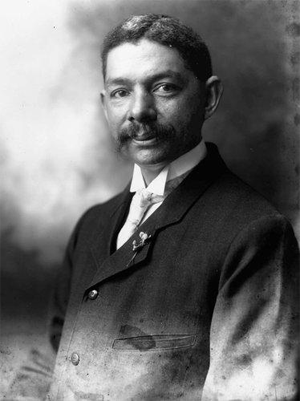
Robert R. Taylor, shown four years after his return to Tuskegee Institute, 1906. Courtesy Library of Congress
Robert R. Taylor to Booker T. Washington, July 1900: "It is not an easy matter to leave off suddenly the effect of seven years continuous work in any line..."
Despite his workload in Cleveland, Taylor's mind remained in Alabama, dreaming up student curricula and keeping track of campus projects. In fact, he continued to work in absentia on various Tuskegee projects, designing and sending down drawings of new campus structures. In Cleveland, Taylor continued to work with the Hopkinson firm and on his independent practice. He and his family lived in a more ethnically diverse neighborhood than they had in segregated Alabama.
Alta Settlement House
According to historic preservationist Eric Johannesen, Taylor likely contributed to the design of the Alta Settlement House, which was located in Cleveland's Little Italy neighborhood and served recent Italian immigrants. Completed in 1901, the landmark building was one of the oldest settlement houses in the city. Funding was provided by John D. Rockefeller Sr., who named the building for his daughter Alta Rockefeller Prentice.
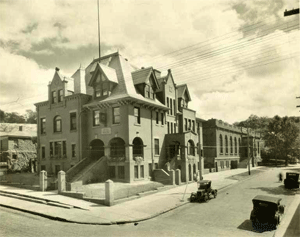
Courtesy Cleveland State University (Michael Schwartz Library, Division of Special Collections, The Cleveland Memory Project
Alta Settlement House for Italian immigrants, likely designed by Robert R. Taylor and completed in 1901.
Slater-Armstrong Memorial Trades' Building (1900)
While still in Cleveland, Taylor sent down plans and specifications to Tuskegee for the Slater-Armstrong Memorial Trades Building. It was completed at a cost of $36,000 and was the largest building on the Institute grounds at the time.
The 27-room building housed the mechanical department. The structure was shaped like a double Greek cross that formed an inner courtyard so that each shop received natural light from two sides. "Better lighted rooms could scarcely be found in any building," wrote Washington in The Story of My Life (1901).
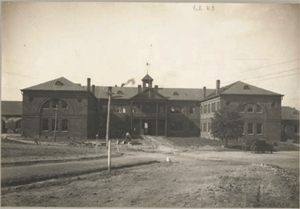
Photo: frances B. Johnston, Courtesy Harvard Art Museums/Fogg Museum, Transfer from the Carpenter Center for the Visual Arts, Social Museum Collection
The Slater-Armstrong Memorial Trades' Building at Tuskegee Institute was designed by Robert R. Taylor and completed in 1900, shown in 1902.
Dorothy Hall (1901)
Dorothy Hall was completed in 1901 and named in memory of Dorothy Lamb Woodridge of the Phelps-Stokes family, one of Tuskegee's earliest major contributors. The building served as the women's trades building, accommodating the Girls' Industrial Department. Classes held in the building included sewing, dressmaking, millinery, laundering, cooking, housekeeping, mattress-making, upholstering, broom-making, and basketry.
In 1938, faculty member George Washington Carver moved from Rockefeller Hall to reside in Dorothy Hall. Also known as the Kellogg Center, today the building serves as a hotel, restaurant, and conference center available for weddings and other events.
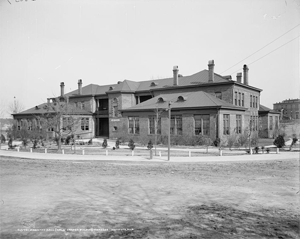
Source: Detroit Publishing Company, Library of Congress
Dorothy Hall was designed by Robert R. Taylor for Tuskegee Institute and completed in 1901.
Carnegie Library Building (1901)
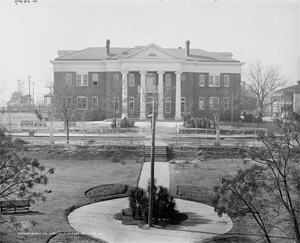
Source: Detroit Publishing Company, Library of Congress
The Carnegie Library Building at Tuskegee Institute was designed by Robert R. Taylor and completed in 1901.
Scottish-American industrialist and philanthropist Andrew Carnegie was a major supporter of Tuskegee, as well as of the National Negro Business League, also founded by Washington. Carnegie donated $20,000 for the building and furnishings of the Carnegie Library, Tuskegee Institute's first library. Between 1883 and 1929, he contributed to the building of over two thousand other "Carnegie Libraries" worldwide, including some belonging to public and university library systems. Taylor himself would later design such Carnegie libraries at black colleges in Marshall, Texas and in Salisbury, North Carolina.

Photo: Frances B. Johnson, reproduced from the collections of the Library of Congress
Tuskegee Institute faculty members, including Booker T. Washington (seated front row, third from left), Andrew Carnegie (seated front row, second from right), and Robert R. Taylor (standing second from right), 1906.
Taylor's Carnegie building at Tuskegee was a two-story, colonial-style building who facade boasts four Ionic columns. Besides the library and librarian offices, the building housed a large assembly-room, an historical room, and study-rooms. The library was intended to be a repository of information regarding African-American literature; black authors were asked to contribute their works and other papers to the collection.
Taylor's design earned praise from various parts of the country. He later designed Carnegie Libraries at two other black colleges: Livingstone College in Salisbury, North Carolina (1908) and Wiley University in Marshall, Texas (1910).
Carnegie Library would serve as the library until 1932, when the Hollis Burke Frissell Library was built. In 1931, the music department moved in, and the building was renamed Carnegie Music Hall. Today the building houses Financial Aid and other services.
RETURN TO TUSKEGEE: 1903
Though Taylor had been traveling between Cleveland and Tuskegee, he finally returned to the Institute in 1903. This time he served as both architect and administrator, heading the Department of Mechanical Industries and overseeing buildings and grounds until his retirement in the mid-1930s.
Taylor's value to Tuskegee was such that Washington had made efforts to attract him back. For every professional offer that came Taylor's way thereafter, Washington made certain that Tuskegee would match or better it. In 1906, he wrote to Tuskegee board member Robert Curtis Ogden:
... in order to be absolutely sure of retaining Mr. Taylor's services, in my opinion I am sure we will have to add four or five hundred dollars to his present salary. The Oklahoma people are very insistent and very tempting in their offers. As I have told Mr. Peabody [George Foster Peabody, wealthy white banker and benefactor of Tuskegee], I should consider it a far-reaching calamity for us to lose Mr. Taylor at Tuskegee.
-- Booker T. Washington to Robert Curtis Ogden, 28 May 1906, Booker T. Washington Papers, vol. 9 (1906-08), pp. 13-14.
Even though later in his career he was offered a number of more lucrative positions, including a presidency at Langston University in Oklahoma, Tayor preferred to remain at Tuskegee believing that he "could be of more service to the race in helping to develop this institution in its industrial side than in other places” [Clement Richardson, National Cyclopedia of the Colored Race (Montgomery, Ala.: National Publishing Company, 1919), vol. 1, p. 494].
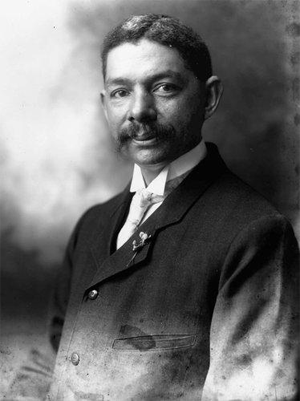
Robert R. Taylor, ca. 1906. Courtesy Tuskegee University
Administration / Office Building (1902-03)
Opened in 1902, the Administration or Office Building would serve as the main school office building for the next 75 years. The building also housed Tuskegee's first post office and bank.
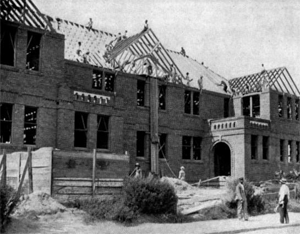
The Administration Building in the process of erection by student carpenters. Source: TUSKEGEE & ITS PEOPLE: Their Ideals and Achievements edited by Booker T. Washington (D. Appleton & Co., 1906)
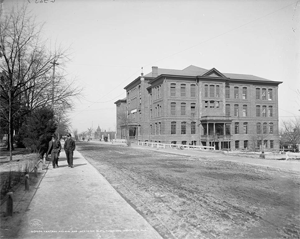
Source: Detroit Publishing Company, Library of Congress
The Administration Building at Tuskegee Institute was designed by Robert R. Taylor and completed between 1902 and 1903, shown ca. 1906.

